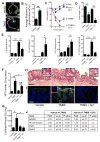Transmigrating neutrophils shape the mucosal microenvironment through localized oxygen depletion to influence resolution of inflammation
- PMID: 24412613
- PMCID: PMC3951457
- DOI: 10.1016/j.immuni.2013.11.020
Transmigrating neutrophils shape the mucosal microenvironment through localized oxygen depletion to influence resolution of inflammation
Abstract
Acute intestinal inflammation involves early accumulation of neutrophils (PMNs) followed by either resolution or progression to chronic inflammation. Based on recent evidence that mucosal metabolism influences disease outcomes, we hypothesized that transmigrating PMNs influence the transcriptional profile of the surrounding mucosa. Microarray studies revealed a cohort of hypoxia-responsive genes regulated by PMN-epithelial crosstalk. Transmigrating PMNs rapidly depleted microenvironmental O2 sufficiently to stabilize intestinal epithelial cell hypoxia-inducible factor (HIF). By utilizing HIF reporter mice in an acute colitis model, we investigated the relative contribution of PMNs and the respiratory burst to "inflammatory hypoxia" in vivo. CGD mice, lacking a respiratory burst, developed accentuated colitis compared to control, with exaggerated PMN infiltration and diminished inflammatory hypoxia. Finally, pharmacological HIF stabilization within the mucosa protected CGD mice from severe colitis. In conclusion, transcriptional imprinting by infiltrating neutrophils modulates the host response to inflammation, via localized O2 depletion, resulting in microenvironmental hypoxia and effective inflammatory resolution.
Copyright © 2014 Elsevier Inc. All rights reserved.
Figures







Comment in
-
What doesn't kill you makes you stronger: the anti-inflammatory effect of neutrophil respiratory burst.Immunity. 2014 Jan 16;40(1):1-2. doi: 10.1016/j.immuni.2013.12.003. Immunity. 2014. PMID: 24439260
References
-
- Amulic B, Cazalet C, Hayes GL, Metzler KD, Zychlinsky A. Neutrophil function: from mechanisms to disease. Annual review of immunology. 2012;30:459–489. - PubMed
-
- Beck PL, Ihara E, Hirota SA, MacDonald JA, Meng D, Nanthakumar NN, Podolsky DK, Xavier RJ. Exploring the interplay of barrier function and leukocyte recruitment in intestinal inflammation by targeting fucosyltransferase VII and trefoil factor 3. American journal of physiology. Gastrointestinal and liver physiology. 2010;299:G43–53. - PMC - PubMed
-
- Bobrie A, Krumeich S, Reyal F, Recchi C, Moita LF, Seabra MC, Ostrowski M, Thery C. Rab27a supports exosome-dependent and -independent mechanisms that modify the tumor microenvironment and can promote tumor progression. Cancer research. 2012;72:4920–4930. - PubMed
-
- Brinkmann V, Reichard U, Goosmann C, Fauler B, Uhlemann Y, Weiss DS, Weinrauch Y, Zychlinsky A. Neutrophil extracellular traps kill bacteria. Science (New York, NY. 2004;303:1532–1535. - PubMed
-
- Campbell EL, MacManus CF, Kominsky DJ, Keely S, Glover LE, Bowers BE, Scully M, Bruyninckx WJ, Colgan SP. Resolvin E1-induced intestinal alkaline phosphatase promotes resolution of inflammation through LPS detoxification. Proceedings of the National Academy of Sciences of the United States of America. 2010;107:14298–14303. - PMC - PubMed
Publication types
MeSH terms
Substances
Grants and funding
- R01 DK088663/DK/NIDDK NIH HHS/United States
- P50 CA058187/CA/NCI NIH HHS/United States
- R01 CA162226/CA/NCI NIH HHS/United States
- DK095491/DK/NIDDK NIH HHS/United States
- R01 DK103639/DK/NIDDK NIH HHS/United States
- DK088663/DK/NIDDK NIH HHS/United States
- UL1 TR001082/TR/NCATS NIH HHS/United States
- DK050189/DK/NIDDK NIH HHS/United States
- R01 CA108610/CA/NCI NIH HHS/United States
- R01 HL060569/HL/NHLBI NIH HHS/United States
- R01 DK050189/DK/NIDDK NIH HHS/United States
- I01 BX002182/BX/BLRD VA/United States
- R29 DK050189/DK/NIDDK NIH HHS/United States
- R37 DK050189/DK/NIDDK NIH HHS/United States
- R01 DK095491/DK/NIDDK NIH HHS/United States
- HL60569/HL/NHLBI NIH HHS/United States
- R01 DK099452/DK/NIDDK NIH HHS/United States
LinkOut - more resources
Full Text Sources
Other Literature Sources
Molecular Biology Databases

